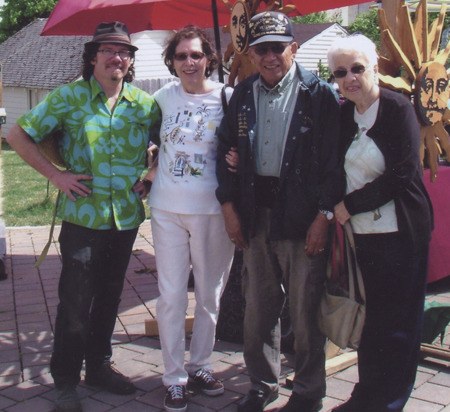Three weeks ago, when the Agricultural Guild opened the historic and reborn Brickworks building, I saw artist Bobby Warren, with his modern hand-carved, painted windmill weather vanes. I stopped to see if I could afford one.
Before I could ask, he said: “Howard, you’re just the one I wanted to see, you were in the service during World War II weren’t you?”
“Four years,” I replied, “Then two during Korea.”
“Great!” he said. “My uncle Joe Aviles is sitting on that bench. He was on the Saratoga aircraft carrier. I’d like a picture of you together.”
“Okay,” I said,”but he might not like being with an infantry shavetail.”
We walked over as Bobby looked for his mom and dad to take the photo. Along came Father Ted Leche, retired priest who served at St. Davids and the other island Episcopalians for decades. He saw me standing with Bobby’s uncle, whose hat listed his service on the historic Saratoga.
“Hey, that was my ship too,” Father Ted said. “I was in the signal/radio unit.”
The USS Saratoga was a super aircraft carrier, one of four ordered by President Eisenhower. It fought during the Vietnam War, but mostly served in the Mediterranean in the ’50s.
“Mi Gawd” said Bobby’s uncle. “That was everybody’s favorite stop. You guys had a real coffee machine around the clock, so that people called to the bridge were delighted to get real coffee on their way up and down.”
Aviles went into the Navy at age 17 (which required his parent’s release if under the age of 18). He joined in 1943, and after joining the Saratoga he was in some of the greatest battles in the Pacific: Tarawa, Bougainville, Rabaul, Coral Sea, Guadalcanal, Iwo Jima and other spots where Japanese airports and bastions were targeted.
He left the service in 1946 as a Gunner’s Mate First Class Seaman, having manned the helm of a famed aircraft carrier at age 20. He signed up with the National Guard, but decided he would try the Army in 1948. He was sent to support the Marines with an armored tank unit at the Battle of Inchon in Korea. After the DMZ was negotiated between North and South Korea, he decided to end his military service in 1953.
Never wounded, he has been a sturdy representative of the millions of veterans who have seen the devastation of war and respects all those who sacrificed their lives and limbs in the horror of war.
I thought of that meeting last week when I heard of Peg Hoeppner’s passing (her memorial service was at the Presbyterian church last Saturday). Peg was the widow of Fred Hoeppner, an ensign on the Battleship California, which was destroyed at Pearl Harbor.
Another islander, Chuck Sharman, reported for duty to ensign Fred Hoeppner on Pearl Harbor day and when the bombs started to drop asked for orders, was told to raise the flag and then save anyone who needed assistance.
Fred, who retired on the island near Snug Harbor became a leader in yacht and sailing activities and for many years wrote many a marine-related column, “Along the Waterfront”, for the Journal, until his death.
Sharman had his boat-home at Shipyard Cove for decades, where he produced the comic strip “Saltchuck”, which was syndicated in many newspapers. He fought cancer for years and had school kids and others submitting comic strip ideas that were drawn up by islanders for months, until he could get back to his regular work.
It’s small wonder that we have so many boaters and ex-Gi’s living in these lovely islands. Roy Matsumoto was persuaded by the late Tom Bogardus, (Roy’s captain) to come here to live after his outstanding and heroic service with Merrill’s Marauders and subsequent 30-year career with the U.S. Army.
There’s something about these islands that makes past troubles become smaller, whether they are from war times or other hard times. Thus we have one of the largest American Legion posts in the state, capably led by Shannon Plummer.
Enjoy this Fourth of July, guys and gals. You all deserve it.
— Go with the F.L.O.W. (Ferry Lovers Of Washington)



